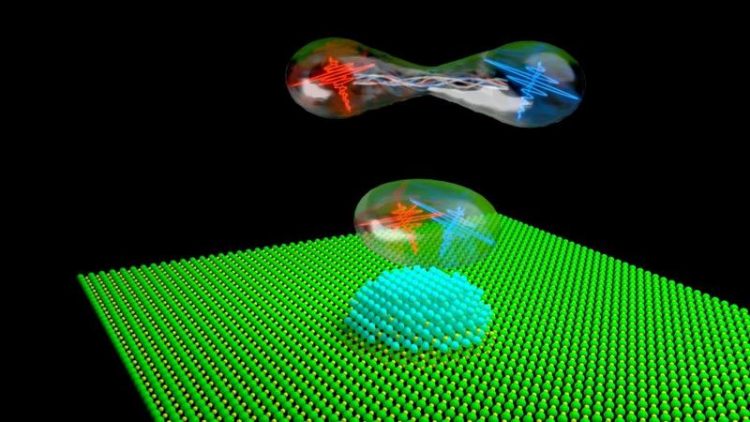Entangling photons from a quantum dot in the telecom C-band

Schematic representation of a quantum dot emitting polarization entangled photons. The entanglement is here pictorially represented by the transparent connection between the two photons. Sascha Kolatschek, Universität Stuttgart / IHFG
Quantum dots are one of the most prominent and promising candidates as non-classical light sources applied in quantum information technology. They have been proven to be able to emit single, indistinguishable and also polarization-entangled photon pairs via the biexciton-exciton cascade.
All these properties have been demonstrated in the NIR regime (i.e. around 900 nm) and here, for the first time, the entangled photon emission was increased up to 1550 nm, key wavelength for fiber-based long-distance classical and quantum communication.
So far the best QD performances have been realized using InAs dots on GaAs platform (naturally emitting at NIR wavelength). This motivated the team of Prof. Dr. Peter Michler to push such a technology up to telecommunication wavelengths.
After long efforts, in close collaboration with the epitaxy team led by Dr. Michael Jetter, it was possible to reach such a milestone, i.e. utilizing In(Ga)As dots to emit telecom-wavelength photons.
The demonstrated entanglement generation in such a system foresees the possibility to extend the unique capabilities reached at NIR up to telecom wavelength. Emission in this regime represents a fundamental skill for fiber-based applications and additionally it is useful for satellite communication, since it marks an atmospheric transmission window.
After the verification of the single-photon nature of the harvested light, moreover an extraordinary low exciton fine-structure splitting (FSS) for most of the investigated quantum dots was measured: indeed, a large FSS inhibits the entanglement generation with high fidelity.
Motivated by this observation, a set of polarization-resolved cross-correlation experiments was performed on an exemplary dot in order to reconstruct the two-photon polarization state that finally reveals the degree of entanglement.
It was found that the detected photons are indeed entangled, which opens the path towards the application of quantum dots in long-distance communication and cryptography schemes. This work represents an important step forward towards the realization of long-distance quantum applications.
Media Contact
More Information:
http://www.uni-stuttgart.de/All latest news from the category: Physics and Astronomy
This area deals with the fundamental laws and building blocks of nature and how they interact, the properties and the behavior of matter, and research into space and time and their structures.
innovations-report provides in-depth reports and articles on subjects such as astrophysics, laser technologies, nuclear, quantum, particle and solid-state physics, nanotechnologies, planetary research and findings (Mars, Venus) and developments related to the Hubble Telescope.
Newest articles

High-energy-density aqueous battery based on halogen multi-electron transfer
Traditional non-aqueous lithium-ion batteries have a high energy density, but their safety is compromised due to the flammable organic electrolytes they utilize. Aqueous batteries use water as the solvent for…

First-ever combined heart pump and pig kidney transplant
…gives new hope to patient with terminal illness. Surgeons at NYU Langone Health performed the first-ever combined mechanical heart pump and gene-edited pig kidney transplant surgery in a 54-year-old woman…

Biophysics: Testing how well biomarkers work
LMU researchers have developed a method to determine how reliably target proteins can be labeled using super-resolution fluorescence microscopy. Modern microscopy techniques make it possible to examine the inner workings…





















